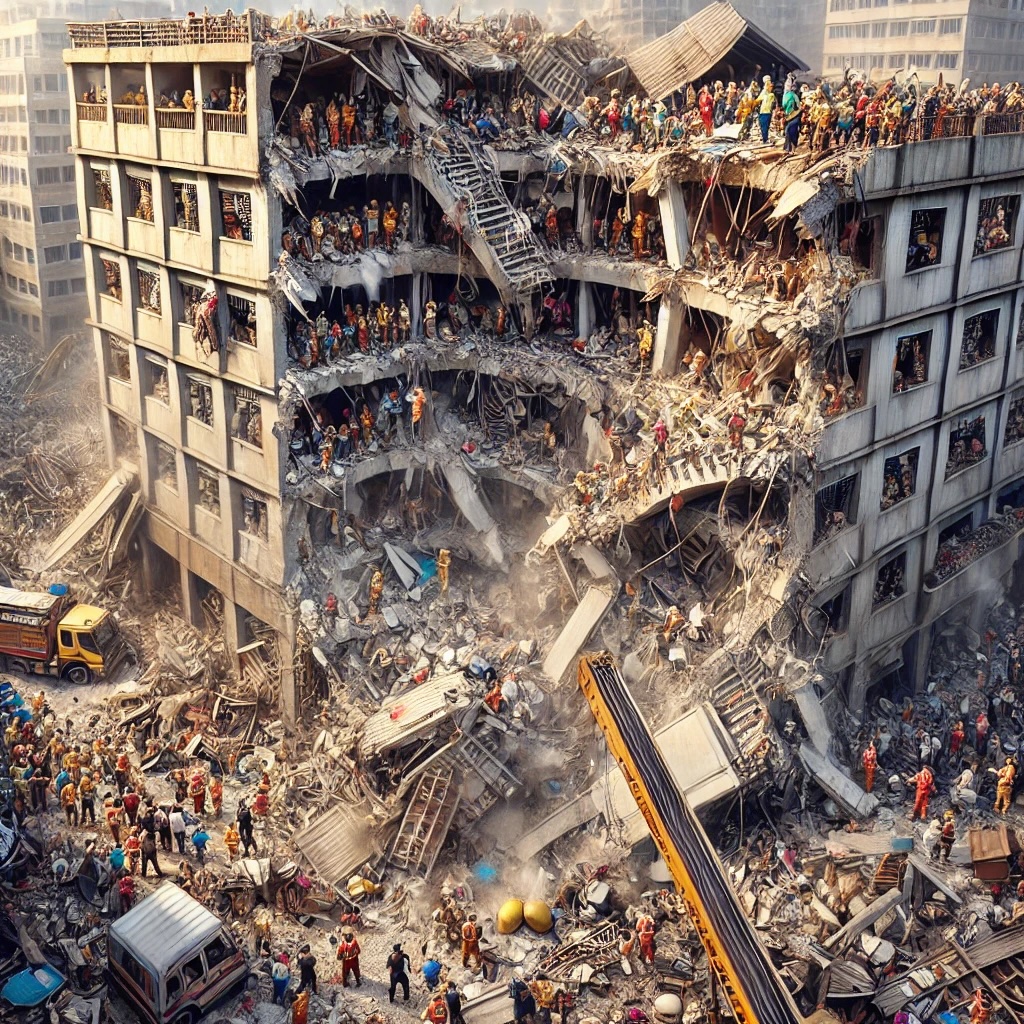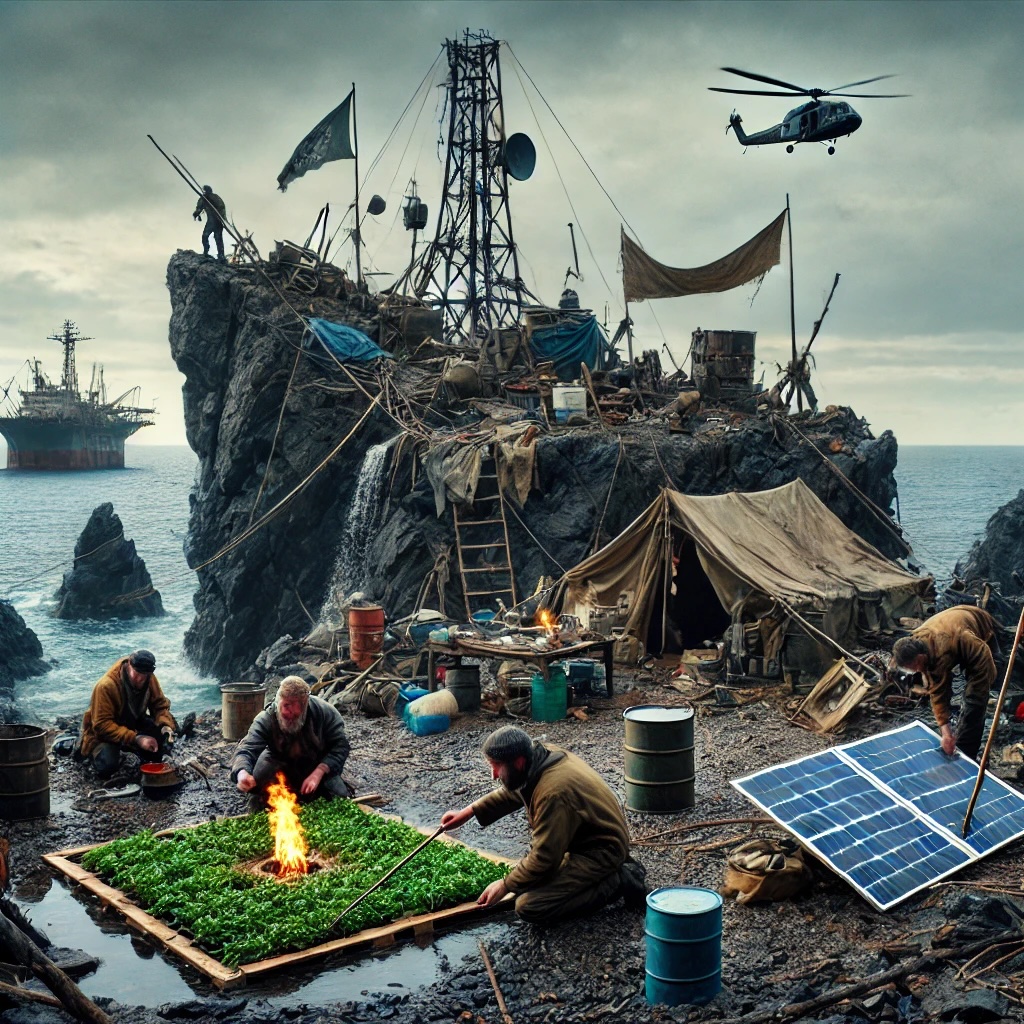Voices from the Rubble: Stories of Rana Plaza Survivors
On April 24, 2013, the collapse of the Rana Plaza garment factory in Dhaka, Bangladesh, sent shockwaves around the world. The building housed several garment factories, producing clothes for international brands, and when it came crashing down, it left over 1,100 dead and thousands more injured. While the media focused on the devastation, the true heart of the story lies in the survivors — those who were trapped beneath the rubble for hours, days, or even weeks before being rescued. Their stories of pain, perseverance, and hope shed light on the human cost of the global fashion industry. In the years since the collapse, many of these survivors have faced a long road to recovery, their lives forever changed by that single day.

Trapped Beneath the Rubble: A Fight for Survival
Shahana Begum, a 26-year-old seamstress, remembers the warning signs. The day before the collapse, cracks had appeared in the walls of the building. Many workers, like Shahana, were scared to enter, but they were given no choice. Factory managers told them that if they didn’t come to work, they would lose their jobs. The following day, as Shahana sat at her sewing machine, the building began to shake, and within seconds, the floor gave way beneath her feet.
Shahana was buried in the rubble for 17 hours. In the darkness, she could hear the cries of her coworkers, some nearby and others fading as time passed. The heat, the dust, and the suffocating weight of the concrete crushed her body and her spirit. When rescuers finally pulled her from the wreckage, she was alive, but her legs were severely injured, and her future uncertain.
Another survivor, Alamgir Hossain, recalls being trapped for more than two days. “I didn’t know if I would make it out alive,” he said. “I prayed for my family, for my children. I wanted to see them one more time.” His hand was pinned under a beam, and he suffered from severe dehydration. Alamgir’s story, like so many others, is one of miraculous survival, but also of unimaginable trauma.
The Long Road to Recovery
For many survivors, the collapse was just the beginning of their struggles. Physical injuries — from broken limbs to spinal damage — left many unable to work again. Shahana, who underwent multiple surgeries to save her legs, now walks with a limp. Once a skilled seamstress, she is no longer able to work in the fast-paced, physically demanding environment of a garment factory. She receives a small amount of compensation, but it is not enough to support her family, and finding alternative employment has proven difficult.
For others, the emotional scars have been just as deep. Alamgir, though physically recovered, suffers from post-traumatic stress disorder (PTSD). He often has flashbacks to those terrifying hours beneath the rubble, waking up in the middle of the night in a cold sweat. “I can still hear the cries,” he says. “I can still feel the weight of the concrete pressing down on me.” Counseling and mental health support are limited in Bangladesh, and many survivors like Alamgir are left to cope with their trauma alone.
Progress and Ongoing Challenges in Worker Rights
In the aftermath of the disaster, international pressure led to significant reforms in Bangladesh’s garment industry. The Bangladesh Accord on Fire and Building Safety was signed by major global brands and aimed to improve working conditions and prevent future tragedies. Thousands of factories have since been inspected, and many unsafe buildings have been closed or retrofitted. Some survivors, like Shahana, are grateful that their suffering led to these changes, but they also know that much more needs to be done.
Despite these improvements, many garment workers in Bangladesh continue to face dangerous working conditions. The pressure to produce clothing quickly and cheaply means that corners are often cut, and worker safety is not always the priority it should be. Low wages remain a major issue. The average garment worker in Bangladesh earns around $100 per month, barely enough to cover basic living expenses. For survivors like Alamgir, who can no longer work, the lack of a social safety net means they are often left to fend for themselves.
Moreover, the factories have simply shifted to new areas. While efforts to improve safety in Dhaka have been somewhat successful, new garment hubs are emerging in places like Chittagong and Gazipur, where regulation is even more lax, and working conditions remain dire. As demand for fast fashion continues to grow globally, these new factories are filling the gap, but at the expense of worker rights and safety.
A Glimmer of Hope: The Rise of Worker Activism
One positive outcome of the Rana Plaza tragedy has been the rise of worker activism in Bangladesh. Survivors like Shahana have become vocal advocates for labor rights, speaking out against the exploitation that still pervades the industry. Many survivors have joined worker unions and labor organizations, pushing for higher wages, better safety measures, and the right to organize.
There are signs of progress. In 2018, a wave of strikes swept through Bangladesh’s garment industry as workers demanded higher pay and safer conditions. Though met with resistance from factory owners, the strikes highlighted the growing power of workers in an industry that has long exploited them. Survivors of Rana Plaza are often at the forefront of these movements, determined to ensure that no one else has to endure the pain and suffering they have experienced.
What Still Needs to Change
Despite these positive developments, much remains to be done. Survivors continue to struggle, both physically and emotionally, and the garment industry in Bangladesh still faces significant challenges. Workers need fair wages, safer conditions, and the ability to voice their concerns without fear of losing their jobs.
The global fashion industry also has a role to play. International brands must commit to ethical sourcing practices, ensuring that the workers who make their clothing are treated with dignity and respect. Consumers, too, can make a difference by choosing to support brands that prioritize worker rights and sustainability over profit.
Conclusion: The Resilience of the Human Spirit
The Rana Plaza disaster was a tragedy of unimaginable proportions, but the stories of its survivors also highlight the resilience of the human spirit. Shahana, Alamgir, and countless others have faced challenges that most of us can barely imagine, yet they continue to fight for a better future — for themselves, for their families, and for the millions of garment workers across Bangladesh.
Their voices from the rubble serve as a reminder that while progress has been made, the fight for worker rights and safety is far from over. If we are to truly honor the memory of those who perished in Rana Plaza, we must listen to the survivors and continue to push for lasting change in an industry that has too often put profit over people.
The Rana Plaza Disaster: A Tragedy that Changed the Garment Industry
On April 24, 2013, the world was shaken by one of the deadliest industrial disasters in history. The Rana Plaza collapse in Dhaka, Bangladesh, claimed over 1,100 lives and left more than 2,500 injured. This tragedy exposed the severe dangers faced by workers in the global garment industry and brought the issue of corporate responsibility and workers’ rights into sharp focus.
The Day of the Disaster
Rana Plaza was an eight-story commercial building that housed several garment factories producing clothing for major international brands. Despite visible cracks in the building’s structure the day before, factory workers were forced to return to their jobs. When the building collapsed during the morning rush of workers, the consequences were devastating. The floors pancaked, trapping thousands under rubble, and rescue efforts lasted for weeks, uncovering harrowing stories of survival and loss.

Why Rana Plaza Collapsed
The collapse was a direct result of a combination of factors, all tied to negligence, corruption, and the pursuit of profit at the expense of safety. Rana Plaza had been illegally expanded; the upper floors were not designed to support the weight of the heavy machinery used in garment production. Moreover, the building’s structural integrity had been compromised by poor construction materials and lax safety standards. Factory owners, under pressure to meet production deadlines for Western brands, ignored warnings about the building’s condition. Tragically, workers had no choice but to risk their lives, as refusing to work meant losing their livelihoods.
The Global Response
The Rana Plaza disaster sparked outrage across the world, putting the spotlight on the exploitative conditions in which millions of garment workers labor. In its aftermath, global attention shifted to the fashion industry’s supply chains, with consumers and advocacy groups calling for greater transparency and accountability.
The catastrophe led to the creation of the Bangladesh Accord on Fire and Building Safety, a legally binding agreement between fashion brands, trade unions, and NGOs, aimed at improving workplace safety in Bangladesh’s garment industry. The Accord introduced mandatory factory inspections and corrective actions to prevent future tragedies. Its implementation was hailed as a significant step toward protecting workers in an industry notorious for its unsafe conditions.
The Human Cost of Fast Fashion
Rana Plaza forced the world to confront the true cost of fast fashion. The disaster highlighted the profound disconnect between the high demand for cheap, trendy clothes in developed countries and the dangerous, low-wage labor that enables such consumption. Many of the victims of Rana Plaza were young women, the backbone of the garment industry, who worked long hours in unsafe environments for poverty wages.
As consumers became more aware of these conditions, there was a shift towards ethical fashion. Brands that were implicated in the Rana Plaza disaster faced public backlash and were pushed to reassess their sourcing practices. Some consumers began to demand more ethical clothing options, contributing to the rise of slow fashion, which emphasizes sustainable and humane production practices.
Lessons Learned and Challenges Ahead
While the Rana Plaza disaster led to reforms and a global conversation about workers’ rights, challenges remain. Many factories in developing countries still operate under unsafe conditions, and workers often lack the power to advocate for their rights. While the Bangladesh Accord has improved safety for many garment workers, similar initiatives have yet to be implemented widely in other countries with significant garment industries, like India, Cambodia, and Vietnam.
The drive for profits continues to overshadow the need for human dignity in many parts of the supply chain. Brands are still grappling with how to balance ethical production with consumer demand for affordable fashion. While some progress has been made, there is still a long way to go to ensure that tragedies like Rana Plaza never happen again.
Moving Forward
The Rana Plaza disaster remains a stark reminder of the human cost of fast fashion and the dangerous working conditions faced by millions of workers around the world. The reforms that followed show that change is possible, but the responsibility for ensuring safe working conditions does not rest solely with governments or factory owners. Fashion brands, consumers, and policymakers must work together to demand transparency and accountability across the industry.
As consumers, we have the power to influence change. By supporting ethical fashion brands, demanding transparency, and raising awareness, we can help build a future where no worker has to risk their life for the clothes we wear.
Rana Plaza is a sobering chapter in the story of modern industry—a call to action that continues to resonate today.
Navigating the Road to Recovery: Americans' Experiences with Personal Injury Attorneys in Transportation Accidents
According to the Insurance Research Council, victims who hire a personal injury attorney in motor vehicle accident cases receive, on average, 3.5 times more compensation than those who don’t have legal representation.
Every day, millions of Americans hit the road, whether driving to work, running errands, or embarking on long-haul trips. With this frequent transportation activity comes the inevitable reality of accidents—ranging from minor fender-benders to catastrophic crashes involving commercial trucks, motorcycles, and other vehicles. When the unthinkable happens and someone is injured in an accident, the road to recovery often involves not just physical and emotional healing but navigating a complex legal system. For many, personal injury attorneys become a crucial part of this journey.
The Role of Personal Injury Attorneys in Transportation Accidents
Personal injury attorneys play a significant role in helping individuals recover damages after transportation accidents. These legal professionals specialize in representing people who have been injured due to someone else’s negligence or recklessness, particularly in car, truck, and motorcycle accidents.
For the average American, understanding the legal aspects of personal injury claims can be overwhelming. Most people don’t have the legal knowledge needed to deal with insurance companies, negotiate settlements, or take a case to court. This is where personal injury attorneys step in. Their expertise can provide peace of mind and ensure victims are fairly compensated for medical bills, lost wages, pain, suffering, and property damage.
Americans’ Common Experiences with Personal Injury Attorneys

1. Initial Consultation: Demystifying the Process
- For many Americans, the first step in dealing with a personal injury claim is the consultation with an attorney. Most personal injury attorneys offer free initial consultations, where potential clients can discuss their case and the attorney can evaluate its merit. Many individuals are surprised to learn that attorneys typically work on a contingency fee basis—meaning the client only pays if the attorney wins or settles the case. This arrangement makes it accessible for many accident victims, who are often dealing with financial stress due to medical bills and lost wages.
2. Dealing with Insurance Companies
- One of the most common frustrations for those involved in transportation accidents is dealing with insurance companies. Insurance adjusters often work to minimize payouts or may deny claims outright. Many Americans find that once a personal injury attorney is involved, insurance companies take their cases more seriously. Attorneys have experience negotiating with adjusters, understanding the tactics they use, and advocating for a fair settlement.
3. Case Investigations and Gathering Evidence
- Another common experience with personal injury attorneys is the process of gathering evidence. This often involves examining accident reports, interviewing witnesses, reviewing medical records, and, in the case of larger accidents, working with accident reconstruction experts. Clients often express relief knowing that their attorney is handling these complex tasks while they focus on recovering.
4. Settlement vs. Trial
- The majority of transportation accident cases are settled out of court, with personal injury attorneys negotiating a fair settlement on behalf of their clients. However, when a settlement cannot be reached, some cases do go to trial. Clients frequently report that having an attorney handle these negotiations—and represent them in court if necessary—provides peace of mind, especially when the stakes are high in terms of medical bills, future care needs, and lost income.
5. Communication and Support
- A common theme in Americans’ experiences with personal injury attorneys is the importance of clear and consistent communication. For accident victims, this can be a stressful and confusing time, and having an attorney who is accessible and explains the process in simple terms makes a significant difference. Clients often appreciate when attorneys keep them updated on the progress of their case and are responsive to questions or concerns. Attorneys also act as a buffer, handling communications with insurance companies, healthcare providers, and opposing counsel, which reduces stress for the client.
Positive Outcomes and Challenges
For many Americans, working with a personal injury attorney after a transportation accident leads to positive outcomes. Those who would otherwise be left with unpaid medical bills and mounting financial pressure are often able to secure compensation that covers their costs and, in many cases, awards for pain and suffering. Personal injury attorneys can often secure higher settlements than individuals attempting to navigate the process on their own, simply because they understand the law, know how to calculate fair compensation, and are skilled negotiators.
However, not every experience is without challenges. Some clients report that the legal process takes longer than they expected, especially when dealing with large corporations or insurance companies with significant resources. There can also be frustration when a case doesn’t settle quickly, requiring the client to go through prolonged negotiations or even face the possibility of a trial. This can lead to a sense of uncertainty and financial strain for those waiting for compensation.
Transportation-Specific Experiences
Americans who have experienced transportation accidents involving commercial trucks or other large vehicles often face unique legal challenges. These accidents tend to result in more severe injuries, and the process of determining liability can be complex. Commercial trucking companies, for example, may have powerful legal teams and insurers, and determining fault may involve investigating driver logs, vehicle maintenance records, and federal safety regulations.
In cases involving ride-sharing services like Uber or Lyft, Americans have found that the presence of multiple insurance policies—personal and commercial—can further complicate the claims process. Personal injury attorneys with experience in this area are often essential in navigating these multi-layered cases and ensuring that victims are compensated fairly.
Moving Forward: Lessons Learned from Working with Personal Injury Attorneys
For Americans who have been through the experience of working with a personal injury attorney after a transportation accident, there are several key lessons:
- Don’t wait to seek legal advice: Many victims delay reaching out to an attorney, either because they’re unsure if they have a case or because they’re hoping to settle quickly with an insurance company. The earlier an attorney gets involved, the better they can protect the victim’s rights and gather evidence.
- Communication is key: It’s important for clients to be proactive in communicating with their attorney and ensuring that they understand the legal process. Attorneys can be strong advocates, but clients who are engaged in their case tend to have better outcomes.
- Trust the process: While legal cases, especially personal injury cases, can take time, the process is in place to ensure that victims get the compensation they deserve.
Conclusion: Navigating the Aftermath with Help from Attorneys
In the wake of a transportation accident, personal injury attorneys offer vital support to those navigating the recovery process. From handling insurance negotiations to fighting for fair compensation, they provide expertise and advocacy in a time of need. While the journey is not always easy, most Americans who work with personal injury attorneys find that they are essential allies in the fight for justice after an accident. With their guidance, victims can focus on healing and moving forward, knowing their legal needs are in capable hands.
A New Era of Offshore Safety: How Oil Rig Accidents Became a Thing of the Past

In the year 2035, the world woke up to an unprecedented achievement: the complete eradication of offshore oil rig accidents. This marked a turning point for environmental conservation, worker safety, and global energy production. The path to this new reality wasn’t easy, but it became a shining example of how technological innovation, international cooperation, and sustainable practices can work together to transform industries once fraught with danger.
The Turning Point: A Revolution in Offshore Technology
The foundation of this transformation began with breakthroughs in automation and artificial intelligence (AI). Decades of research into deep-sea robotics and predictive AI systems finally bore fruit. The oil industry invested in AI-driven rigs, where human error—a key cause of past disasters—was virtually eliminated. Sophisticated machine learning algorithms were able to anticipate equipment failure and potential hazards before they escalated into catastrophic events.
These rigs are now equipped with cutting-edge technology, from drones and autonomous submersibles that monitor equipment at extreme depths, to hyper-responsive AI systems capable of instant decision-making in critical moments. No longer do crews face the perilous conditions of the high seas; instead, they operate from control rooms onshore, guiding the process with precision, oversight, and data-rich insights.
Renewable Energy Integration
What’s more, this revolution didn’t happen in isolation. As the demand for fossil fuels gradually declined, oil companies embraced hybrid energy platforms. Offshore rigs were retrofitted to accommodate wind turbines and solar panels, converting once carbon-heavy operations into green energy hubs. Now, these hybrid platforms use renewable energy to power drilling and extraction processes while contributing to the grid with sustainable electricity.
By diversifying energy production, companies reduced their environmental footprint. And with fewer rigs relying solely on oil extraction, the pressure to produce at any cost diminished. This pivot toward a more sustainable, multi-faceted energy infrastructure dramatically reduced the likelihood of oil spills and other environmental disasters.
Global Cooperation and Stricter Regulations
This new era of safety didn’t come about through technology alone. International regulations took a significant leap forward as governments across the globe aligned to create stringent, unified safety standards. The creation of the Global Offshore Safety Council (GOSC) brought together scientists, engineers, and policy experts to enforce rigorous safety protocols.
All oil rigs, from the North Sea to the Gulf of Mexico, now adhere to these unified guidelines, ensuring that there’s no room for negligence. Countries that once vied for profits at the expense of safety are now part of a global network committed to protecting marine ecosystems and ensuring the safety of rig workers.
The Human Element: Skilled Workers in the Digital Age
With the rise of automated rigs, the role of offshore workers shifted dramatically. Rather than risking their lives in the field, engineers and specialists now remotely operate rigs from onshore control centers. These jobs require new skills in robotics, data analysis, and AI oversight, creating a safer and more fulfilling work environment for a new generation of oil and energy professionals.
Oil companies have invested heavily in upskilling their workforce, offering educational programs in advanced technology and environmental science. The result? A highly educated workforce that plays a pivotal role in maintaining safety, efficiency, and environmental responsibility.
The Environmental Impact: A Healthier Ocean
Perhaps the greatest victory in this new reality is the dramatic reduction in environmental impact. Gone are the days of devastating oil spills that left marine life in peril and coastlines soaked in oil. Coral reefs that had been endangered by decades of oil-related incidents are now thriving. Aquatic ecosystems once devastated by human error have been given a second chance to flourish.
Oil production is now conducted in harmony with the environment, with automated systems ensuring that every drop extracted is done so with minimal disruption to the surrounding ocean. Moreover, hybrid energy platforms contribute to the reduction of carbon emissions, slowing the advance of climate change and allowing the world to progress toward a greener future.
Looking Ahead: A Blueprint for Other Industries
The success of offshore oil rigs becoming accident-free serves as a blueprint for other high-risk industries. The lessons learned here—collaborative innovation, investment in technology, and an unwavering commitment to safety—are already being applied to fields like mining, nuclear energy, and space exploration.
We stand on the brink of a new industrial revolution, where human ingenuity and environmental stewardship work hand in hand. This new era reminds us that the most significant leaps forward often come not from small, cautious steps, but from bold visions that redefine what’s possible.
Conclusion: A Future Worth Believing In
In this world where offshore oil rig accidents are a thing of the past, humanity has proven its ability to evolve beyond old limitations. Through technology, regulation, and global cooperation, we’ve created a safer, more sustainable energy future. The ocean, once a site of risk and danger, is now a symbol of hope—a place where innovation and nature coexist harmoniously.
As we move further into this promising future, the oil rigs of today may very well be the green energy platforms of tomorrow, ensuring a world where safety, sustainability, and progress are intertwined. Offshore accidents may be behind us, but the spirit of transformation continues to push us forward.
Surviving the Unthinkable: The Ingenious Journey of Oilrig Castaways
It began like any ordinary day—waves lapping against the steel hull of the offshore oilrig, the steady hum of machinery, and a crew of seasoned experts going about their work. But when disaster struck, it turned their lives upside down in an instant. A sudden and catastrophic accident sent the oilrig spiraling into chaos, leaving the crew stranded in the most unlikely of places: a small, desolate island in the middle of the ocean.
With limited supplies and no immediate hope of rescue, the crew faced a harsh reality. They had to rely on their ingenuity, training, and camaraderie to survive. This is their story—a tale of resourcefulness and resilience.
Day One: Assessing the Damage
The first hours were frantic. After the initial shock, the crew of engineers, technicians, and specialists quickly transitioned into survival mode. They gathered whatever they could salvage from the wreckage: tarps, ropes, tools, emergency rations, and even scrap metal. What they had was minimal—just enough to get by for a few days. But they knew that rescue could be weeks, even months, away.
The island offered no luxuries: jagged rocks, sparse vegetation, and a few freshwater springs. There were no signs of human life, no natural shelters. This was survival at its rawest.
Day Two: Turning Scrap into Shelter
As oilrig workers, the crew was no stranger to harsh conditions. With their engineering expertise, they transformed the limited materials they had into functional shelter. Using scrap metal from the wreckage, they fashioned windbreaks and makeshift roofs. Tarps were suspended between rocks to create crude tents, and ropes became invaluable in securing everything against the island’s unpredictable weather.
One of the crew members, a welder, ingeniously crafted rudimentary tools from leftover steel—axes, hammers, and hooks. These would prove essential in gathering firewood and foraging for food.
Day Five: Fire and Water—The Essentials
While the shelter provided temporary relief, fire and water became their top priorities. Thankfully, they had managed to save a small supply of flares and waterproof matches. But once those ran out, the crew had to think outside the box.
One crew member—a survivalist at heart—demonstrated the bow drill method to create fire using sticks and friction. It wasn’t easy, but after a few failed attempts, a spark ignited a small blaze. That fire became their lifeline, providing warmth, the ability to cook, and a signal to potential rescuers.
Water filtration was another hurdle. They found a freshwater spring on the island, but it wasn’t enough to sustain the entire crew for an extended period. Using scrap plastic and metal sheets, they built a solar still—a device that condensed seawater into drinkable fresh water. It was a slow process, but it saved their lives.
Week Two: Foraging, Fishing, and Teamwork
By the second week, food supplies were running low. The emergency rations had been rationed carefully, but hunger was gnawing at them. The crew had to get creative. They used salvaged fishing line and hooks from their toolkits to catch fish in the surrounding waters. A mechanical engineer fashioned spears from scrap wood and metal, which proved useful for hunting small game on the island.
A marine biologist on the crew proved to be a valuable asset. She identified which plants were safe to eat and even helped cultivate a small patch of edible greenery using soil they collected from the island’s rocky surface. With time and patience, they began to grow small crops, supplementing their diet with seaweed and the occasional fish.
The crew also discovered a small cove where they could collect crustaceans, which became a source of protein. Their diet was basic but enough to keep them alive and relatively healthy. Teamwork was key, and every crew member contributed their skills—be it fishing, hunting, foraging, or constructing additional shelters.
Week Four: Keeping the Spirit Alive
Survival wasn’t just about physical needs—it was about keeping morale high. The crew knew that isolation could be just as deadly as hunger or dehydration. To combat the creeping sense of despair, they devised ways to stay occupied. One crew member, an electrician, rigged up a basic communication system using old radios, hoping to send distress signals.
The captain initiated daily group meetings, where everyone shared updates, discussed plans, and even told stories to lighten the mood. These moments of unity helped foster a sense of purpose and camaraderie, reminding the crew that they weren’t just surviving—they were living, and there was hope on the horizon.

Week Eight: The Rescue
After nearly two months of survival, their persistence paid off. One morning, a rescue helicopter appeared on the horizon, drawn to the island by the crew’s makeshift signal fires and the faint distress signals they had managed to send using their salvaged equipment. The sight of the helicopter brought cheers and tears—it was the moment they had all been waiting for.
As they boarded the chopper, exhausted but alive, they looked back at the island that had been their unlikely home. They had conquered the harshest elements, relying not just on their tools and knowledge but on each other.
Conclusion: The Triumph of Human Ingenuity
The story of the oilrig castaways is a testament to the power of human ingenuity and resilience. In the face of overwhelming adversity, they transformed their dire situation into one of hope, survival, and triumph. Using their unique skill sets, they turned an uninhabitable island into a livable environment, surviving long enough to await rescue. This tale serves as a reminder that no matter how desolate the circumstances, creativity, expertise, and teamwork can overcome even the most challenging odds.
The adventure may have ended, but the legacy of their survival lives on—a story of determination, resourcefulness, and the unbreakable human spirit.